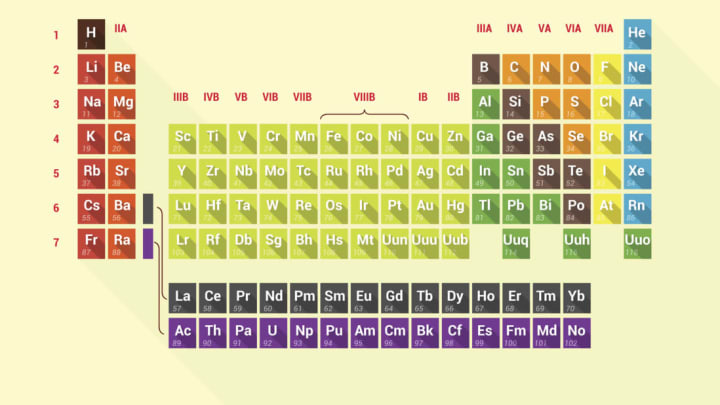Why Do Some Elements Have Symbols That Aren’t in Their Names?
By Matt Soniak

The chemical symbol for oxygen is O. Makes sense. Calcium gets repped by a Ca. Sounds good. Hydrogen? H. Cobalt? Co. Lithium? Li. With you so far. Lead? Pb.
Stop the presses!
There’s no p or b in lead. No h or g in mercury. No f or e in iron. No w in tungsten. What’s going on here? It looks like chemists were maybe under the influence of a little C2H5OH when they came up with these symbols.
There are actually a few things that help explain the dissonance between elements’ names and their symbols, says Sam Kean, author of The Disappearing Spoon and occasional Mental_Floss contributor.
“One answer lies in the cosmopolitan nature of the periodic table,” Kean wrote at Slate a few years ago. The chemical elements were discovered and/or isolated by scientists all over Europe and elsewhere in the world. Sometimes these events weren’t recorded (as with gold or iron, which were known by ancient civilizations and haven’t been credited to a single discoverer), or they happened independently in more than one place, and it’s not clear who did it first. As such, says Kean, “the same substance might go by different names in different places for decades.”
In the spirit of compromise, an element’s name might come from one language, and its symbol from another. That’s the case with tungsten. Its symbol is W, says Kean, “because the Germans call the element ‘wolfram.’ It was a compromise between different countries’ claims.”
Other name-symbol mismatches came about from scientists drawing on research from classical texts written in Arabic, Greek, and Latin, and from the habit of “gentleman scientists” of bygone eras using a mix of the latter two languages as “a common language for men of letters.” The Hg symbol for mercury, for example, derives from the Latin hydragyrum, which means “water silver,” and lead’s Pb symbol comes from its Latin name, plumbum.